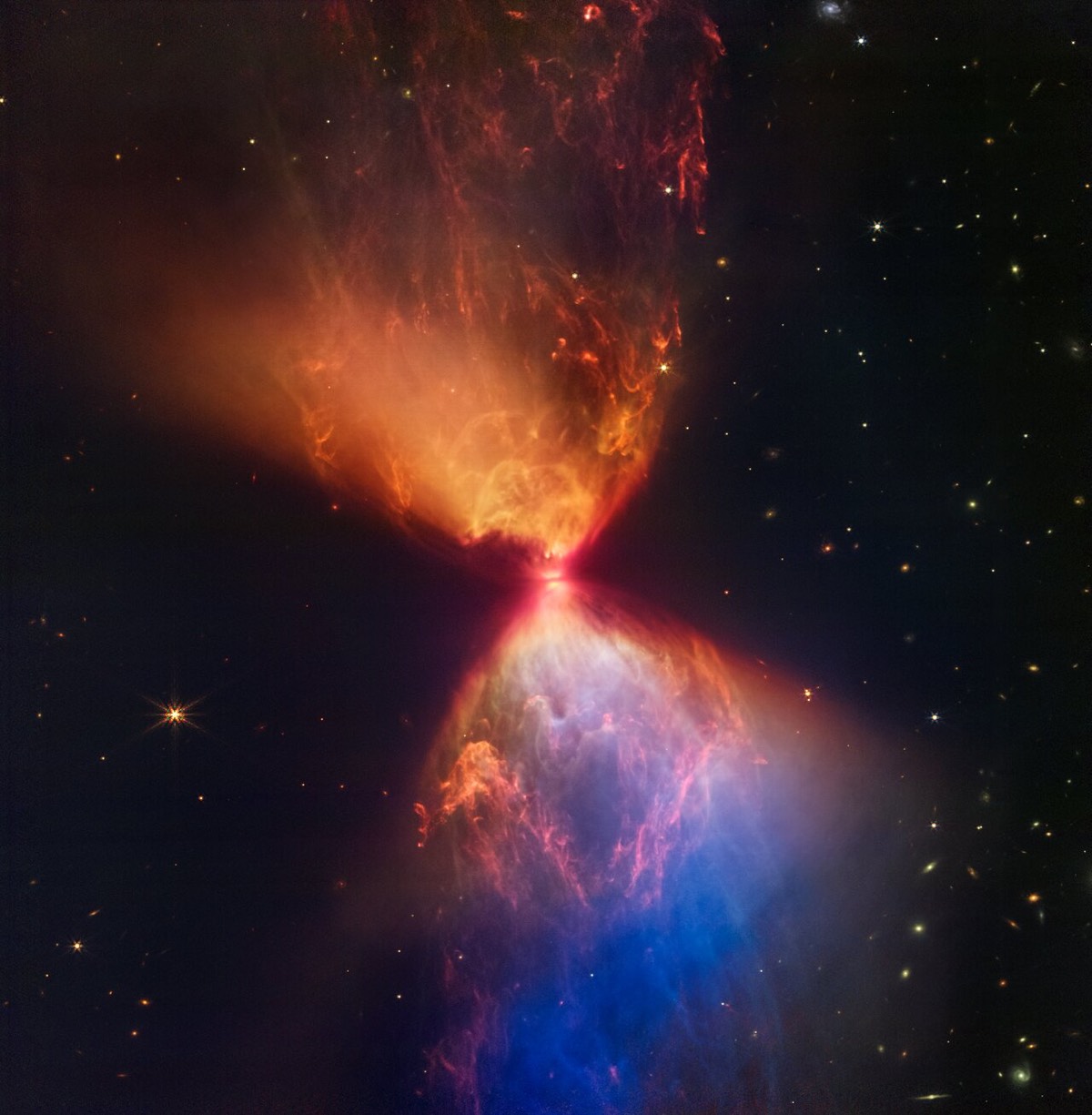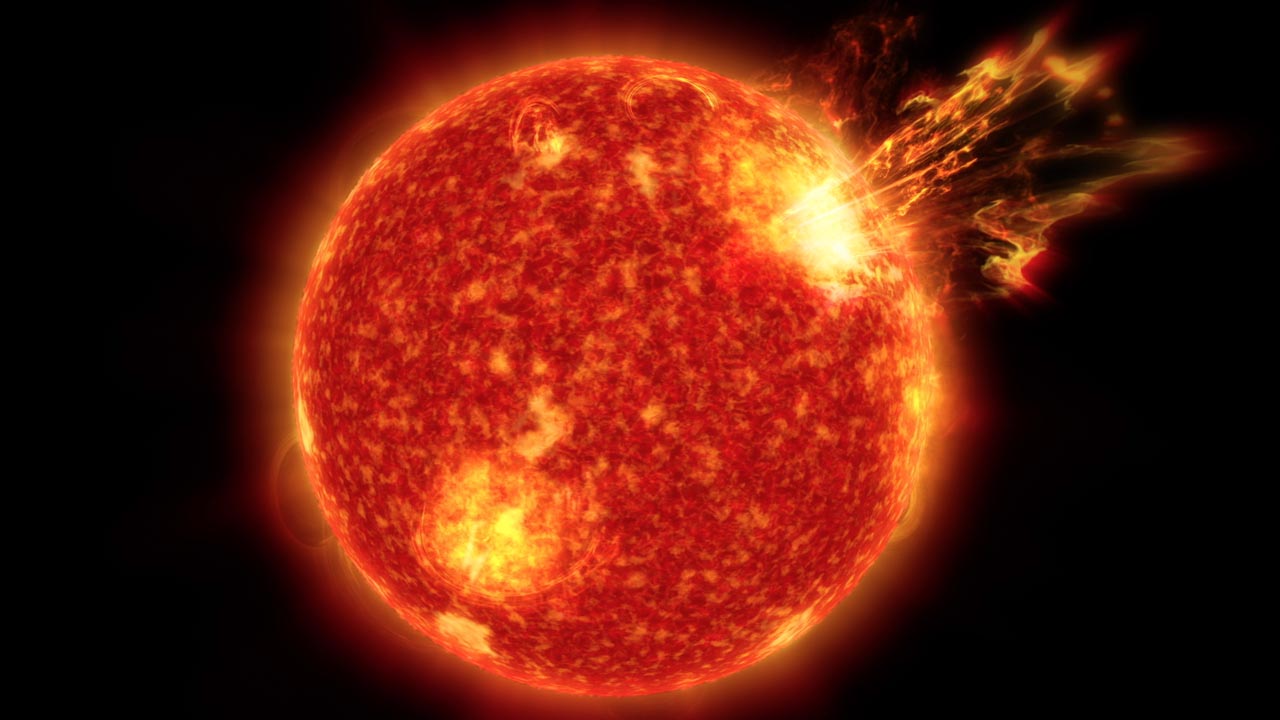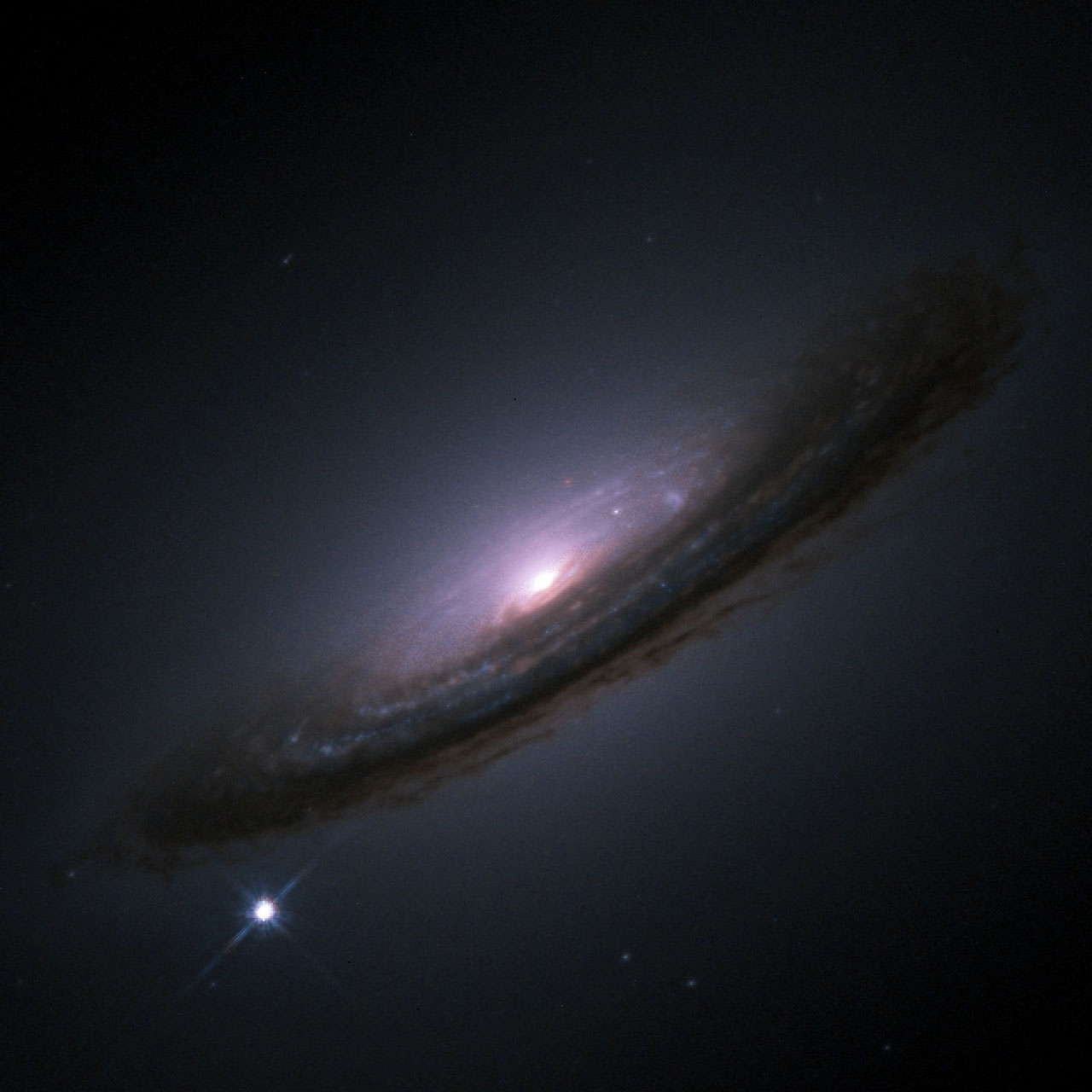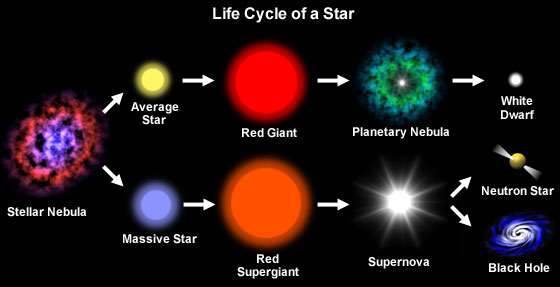The Six Stages of a Star's Life
Stage 1: A Giant Cloud of Gas

Above: The Helix Nebula, located 700 lightyears away from Earth. Image Credit: NASA
Stars begin their life cycles as clouds of gas and dust within a vast expanse of stellar debris called a nebula, formed from the gas and dust expelled by the explosion of a dying massive star. Once formed, a nebula becomes a region in space, often several times larger than our solar system, where new stars are able to form.
Over millions of years gravity slowly pulls clumps of dust and gas, mostly hydrogen and helium, together to form a gas cloud. As these clouds get bigger their gravitational pull gets stronger, pulling in even more dust and gas. Eventually, the cloud gets so large that it's gravity causes it to collapse in on itself, forming a protostar.
Stage 2: The Protostar

Above: A protostar forms an hourglass as the gas cloud contracts into the protostar's core. Image Credit: NASA
In the second stage of a star's life cycle, the giant gas cloud collapses in on itself forming a protostar. The matter at the center of the cloud compresses into a hot, dense core. This core continues to pull in matter from the surrounding gas cloud growing denser and hotter the more matter it consumes. When a protostar first forms, the gas cloud surrounding it is roughly as large as our solar system. It can take anywhere from one hundred thousand to one million years for the gas cloud to fully contract, and for the protostar to become dense and hot enough to transition into the next phase of the star's life.
Stage 3: The T-Tauri Star

Above: Artist's rendition of a T-tauri star. Image Credit: Wikipedia
The T-tauri stage, named for a star discovered in the Taurus constellation way back in 1852, begins once a protostar has collected enough material from the surrounding dust cloud to trigger a process called gravitational collapse. At this point, the gravitational pull of the protostar's dense core causes the massive sphere of matter surrounding the core to collapse in on itself. Matter is pulled into the core, compacted by the pressure of the core's gravitational pull, and gravitational energy is released as heat and light.
T-tauri stars look much like the stars you see at night. Their surface temperatures are about the same as a star of comparable mass, but T-tauri stars shine brighter because they have a larger diameter. Unlike a fully formed star, the core of a T-tauri star is not yet hot enough to ignite the fusion reaction that powers a star like our sun. Instead, the heat and energy expelled by a T-tauri star is generated from the continued gravitational collapse of its mass. A star will remain in the T-tauri stage, slowly collapsing in on itself, expelling gravitational energy, and heating up its core for up to one hundred million years!
Some T-tauri stars don't have enough mass to reach or sustain a fusion reaction. These smaller T-tauri stars will end their life cycles as a Brown Dwarf star, with a mass between the largest gas giant planets and the smallest stars. Brown Dwarf's are dead stars. They give off light and heat at first, but their cores cool down over time and as the core cools the light of the brown dwarf dims, until one day it vanishes from the night sky for good.
When all goes well, a T-tauri star's core will eventually reach the ignition temperature of one million degrees kelvin. A fusion reaction ignites the star's core, and the star enters the fourth stage of it's ten billion year life cycle.
Stage 4: The Main Sequence

Above: The sun entered the main sequence stage over 4.5 billion years ago. Image Credit: NASA
After a hundred million years of gravitational collapse a T-tauri star's core reaches one million degrees Kelvin, igniting a fusion reaction. In the fourth stage of its life cycle, a Main Sequence star is sustained by the fusion reaction of hydrogen into helium taking place inside its core. Within the star's core, two atoms of hydrogen fuse to create one atom of helium and excess energy is expelled as heat. This is an exothermic reaction, meaning the reaction releases more energy than it consumes. The outward force of the energy expelled from this reaction counteracts the inward force of the core's gravitational pull, and the star's core stabilizes. A star like our sun fuses about six hundred million tons of hydrogen every second, yielding 596 million tons of helium and expelling an immense amount of excess energy as light and heat.
Stars spend most of their life in the main sequence stage. A main sequence star the size of our sun has an estimated lifespan of ten billion years. Our sun began its main sequence roughly 4.5 billion years ago, so it still has about 5 billion years to go before it transitions into the fifth stage of its life cycle.
Stage 5: The Red Giant

Above: The size of a red giant relative to the size of our sun. Image Credit: Daniel Huber
Eventually, after billions and billions of years, a main sequence star runs out of hydrogen fuel and can no longer sustain the fusion reaction taking place inside its core. The hydrogen fuel runs out, the hydrogen-helium fusion reaction stalls, and the core stops releasing energy. Since the star's core is no longer expelling energy outward, there is no outward force to counter the inward gravitational collapse of the core.
As the core collapses, the outer shell of plasma that surrounds the core becomes hot enough to begin fusing hydrogen itself. Once fusion begins in the shell, the extra heat causes the outer layers of the star to expand dramatically. Through this process, a star the size of our sun will swell to several hundred times its main sequence size. When our sun eventually expands it will grow so large that its outer shell will cover Mercury, Venus and possibly Earth. No need to panic, though! The sun still has about five billion years to go before it runs out of fuel.
As the star's outer layers expand, the energy contained within the star is spread out over a larger distance. This means the star's energy dissipates more rapidly, and the star begins to cool. A red giant is about half as hot as the sun, despite being several hundred times larger. Because it cools as it expands, it's light gradually changes from blue or yellow to red. It's giant. It's red. Therefore, it's a red giant!
Stage 6: White Dwarves and Supernovas
A star can remain a red giant until the remaining supply of helium in its core runs out. Then it transitions into the final stage of its life cycle. Depending on the size and solar mass of the star, its life will end in one of two ways: as a white dwarf star or as a supernova explosion.
The White Dwarf Star

Above: Image of a white dwarf star. Image credit: BBC Sky Magazine.
A star the size of the sun is considered a low-mass star, and will end its life as a White Dwarf. When it expands into a red giant, the heat and pressure of the gravitational collapse taking place in the core causes the core to fuse helium into carbon. This keeps the core stable as it shrinks over time. When the shrinking core runs out of helium, the fusion reaction ends and the core becomes unstable. The core begins to pulsate, causing powerful stellar winds that eject the star's outer layers into space. The expelled layers form a ring of matter around the core called a planetary nebula. Once the star has shed its layers, all that remains is a small, hot, dense, and incredibly bright core called a White Dwarf, primarily made up of carbon and oxygen. The White Dwarf will slowly cool down over hundreds of billions of years, until it eventually gives off no heat and no light.
The Supernova

Above: A supernova (white spot in the lower left corner) captured at the outer edge of the Andromeda galaxy. Image credit: Nasa
If a star's solar mass is eight times the size of our sun or larger, it is categorized as a massive star. A massive red giant's core will shrink as it fuses helium into carbon. When it runs out of helium, the core continues to shrink as it fuses carbon into iron. Once the carbon runs out, the red giant is left with a very small, dense, and unstable core of iron. While smaller stars slowly shed their outer layers over time, massive stars like to go out with a bang. The dense iron core triggers a sudden, violent gravitational collapse and the massive star implodes in an instant. This extremely powerful implosion triggers a massive explosion called a supernova that scatters the remnants of the star into space, forming a vast new nebula of dust and gas. Depending on the size of the massive star, the implosion of the core will leave behind a small, dense core of tightly packed neutrons called a neutron star or, in larger stars, a black hole with a gravitational pull so powerful that not even light can escape it.

Above: The first ever image of a black hole captured by the Event Horizon Telescope project. Image credit: NASA
At long last, tens of billions of years after it first formed from clumps of dust and gas drifting through a nebula, the star reaches the end of its life cycle with a spectacular explosion. The star's matter is expelled into space, where it forms a vast new cloud of gas and dust and the cycle begins again. From the death of one star, comes the eventual creation of new stars, new planets and possibly, some day, new life.

We hope you enjoyed learning about the six stages of stellar evolution with us! It's pretty amazing to think that much of the matter that makes up the plants, animals, and other life on Earth comes from the remnants of stars that exploded millions of years ago. If you enjoyed learning about the life cycle of stars, check out some of our other Science Explained blogs to learn even more mind blowing facts. You're sure to have a stellar time!
